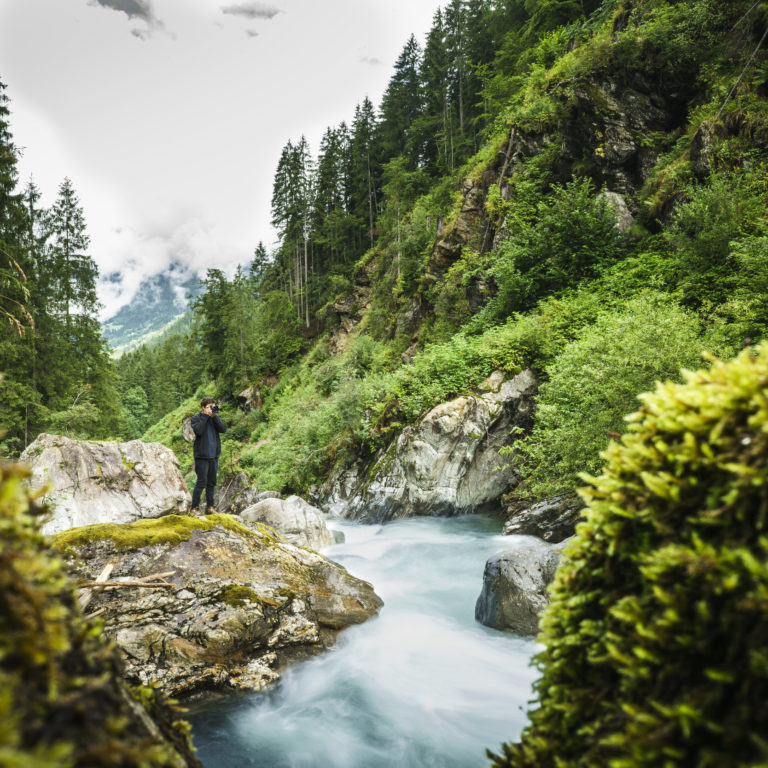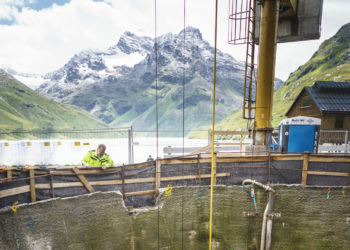
C Litz, Silbertal (c) Dietmar Denger / Vorarlberg Tourismus
It flows. It foams.
Wild water - its beauty and force

C Litz, Silbertal (c) Dietmar Denger / Vorarlberg Tourismus
Wild water - its beauty and force
It is a shame that we spend so little time contemplating the importance of water for our life. It is different in the Montafon: here, in the mountains around the Silvretta, you get a direct sense of its force and its beauty.
TEXT: STEFAN NINK
Sometimes it goes like this: It is very early in the morning, on a hiking path in the Montafon, the valley already some way behind you, the summit still some distance away, and suddenly you feel a drop on your face, followed by another one, and since the weather forecast had predicted good weather and it wasn’t supposed to rain, you put your head back and see – a blue sky.
A couple of light-grey clouds are hanging on in there – maybe they are responsible for the couple of splashes. And over there, on the side of the mountain, there is something shiny. Morning dew, you think, and are amazed that you can actually see it. A bit further up, the sun lights up rivulets – thin, silver veins on grey rock, and above it a field of snow glitters like a mirror. You are standing there on a trail and, for a brief moment, there is something in the air that you could call understanding or even realisation, but before things start getting too philosophical you simply continue on your way. You don’t even realise that the roaring in the background doesn’t actually come from the road below. Instead, it comes from the waterfall on the other side of the valley.
Water can shout at you. Yet it can also produce quiet, almost tender tones.
To be honest, we spend far too little time thinking about water. Especially not when on holiday, although there are no more suitable places than the mountains for doing so. And probably no better place than the Montafon.
Water – it has always been there, and will always be there, hopefully.
The valley of the Ill is edged by mountain ranges towering into the sky, the Rätikon with its lime pinnacles, on the other valley side the Verwall, all mountains, none of them exactly small and, at the end of the valley, there is the Silvretta with its mountains over 3,000 metres high. You cannot exactly claim that the geology in the Montafon has been restrained in any way – naturally, such a landscape has the best possible conditions for water, if it’s possible to say that. Water has one main property: it always wants to flow downwards! When allowed to do so, it displays its beauty. And its force. As well as its power.
So let’s start from the top, on the Silvretta, where the water spends many months of the year as snow and ice. The two milky blue reservoirs of Silvretta and Vermunt provide people with electricity produced from hydropower. All the lorries and containers are here because, between the two lakes, deep inside the mountains, a new hydropower station is being built – the monumental Obervermuntwerk II. For his part, Hansjörg Schwarz is walking around here looking at things since he and the team from the Illwerke are responsible for making sure that no trace of the construction work will be visible once all the excavators and pipes and construction site paraphernalia have disappeared. Ecological construction supervision, as it is known. All the excavation hills from the inside of the mountain, for example, will be planted with perennials and rough grasslands that hikers will consider totally normal hills within three or four years. “The massive project must not be allowed to endanger the scenic beauty of the region,” says Schwarz, “so it’s great if we can correct even the little things in advance.” Anyone who sets out to tame water bears a special responsibility. For nature. “And for people who will want to live in the Montafon after us.”

Obervermuntwerk II
Vorarlberger Illwerke AG is the biggest energy supplier in the region. It generates its electricity exclusively from hydropower and other renewable sources of energy. In total, the company has ten power stations, four reservoirs and several basins. Vorarlberg is a pioneer in the field of alternative energy and clean electricity. “Obervermuntwerk II”, the new pumped-storage hydropower station (photo of the construction site) is set to start operating in 2018. The “Energieraum” in Partenen enables interested parties to have the hydropower plant explained to them by means of multimedia. Put very simply, it will work like a huge storage battery: when required, it provides energy. In the event of over-capacity, the water can be pumped back into the reservoir, which is located 300 metres higher up.
Naturally, only a part of this water is being tamed up here on the Silvretta, and naturally the rest of it wants to flow down into the valley, impetuously and wild, and over paths it has searched for or created for itself over the course of time. In order to get a feeling for what this is like, you just have to hike to the Silbertal after a rainy day. This takes you from Schruns to the east and is considered one of the most original of the valleys in Vorarlberg. There are three or four alps behind Silbertal as well as a handful of weekend houses and then – nothing. No roads, no villages. Just nature. Just steep slopes to the right and to the left and the vast sky above it all, and the snow-covered spiky peaks of Omesspitze and Lobspitze somewhere on the horizon. It is full of families on good weather days. On rainy days it is one thing above all – impressive.
Everywhere – simply everywhere – there is water, it flows in strings from the slopes, it splashes downwards in streams, it thunders in waterfalls, it foams and roars and crashes and bangs. On days like this in the Silbertal, there are minutes where you have to shout to be heard, the water is that loud. As well as moments you would like to whisper so that you don’t disturb the tender passages of the water symphony around you. And if you pay attention, you feel at every breath how the clear, cool air seems to flow right down as far as the finest branchings of the lung.
The people here live with the water,
and know how tame it
“Try it! You have to try it too!” This now comes from Ewald Netzer who is holding his cupped hand out underneath one of the many rivulets. “The water tastes different from every source here!” Netzer was born and bred in this region, and quite possibly there is nobody who knows more about the local water, the springs and its healing power. The Warzenbächle is one such example – people would go to this stream (“wart stream”) to wash their hands, and two weeks later their warts would be gone, he explains. True! Apparently, this is due to the high silver content in the water. “Or maybe due to the faith they have in it. Whatever, gone is gone.”
There was once a health spa in the Silbertal which people used to attend to cure their symptoms as far back as in the 17th century. “And the people from the valley still use the springs.” The snow that spends the winter at high altitude melts between the spring and the autumn, before the world turns back to white. It is a continuous backwards and forwards, up and down, that has been announcing the coming and going of the seasons and the flow of time for thousands of years. The people in the Montafon live with the water, and they have always known how to tame it. It is by applying the art of engineering and great stamina that they have constructed reservoirsand built hydropower stations: they have used the water to operate their sawmills and treated their warts with. They route it to swimming pools and bathing lakes, and local artists such as composer Herbert Willi use it as their source of inspiration for symphonies.
Culture, history and tourism in the Montafon are closely associated with the changeable water, as is its geography. It has always been there, and it will always be there. Hopefully.
An ocean once foamed in the Montafon.
The coral reef has become fossilised.
Culture, history and tourism in the Montafon are closely associated with the changeable water, as is its geography. It has always been there, and it will always be there. Hopefully. All you have to do is take a walk in Bartholomäberg to get an idea of how long the Montafon has been associated with water. Follow the geology trail up as far as the Obere Wiese. Between the grass and the flowers, you will find a fossilised coral reef with fossilised shells, sea lilies and, naturally, coral stocks. Once upon a time, an ocean used to froth and foam here. Until the earth decided there was something missing. And it created the Montafon, with its mountains and peaks towering up heavenwards, and the valleys between them.